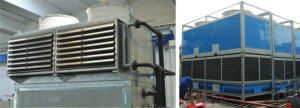Evaporative cooler
The evaporative cooler is an evolution of the evaporative tower, that employs a heat exchanger in substitution of the filling thermal exchange pack. In fact, in this machine the thermal transfer exploits the benefits of water evaporation (evaporation latent heat) with the additional benefit of having the fluid to be cooled in a closed circuit. Water is therefore contamination-free being separated from the air circulating within the cooler that achieves the thermal transfer.
In this kind of machinery, the fluid to be cooled flows in a thermal transfer array of tubes, which is sprayed with water of the evaporative cooling cycle. In fact, the fluid to be cooled can consist of water or also non-freezing solutions or oily solutions, or even hydraulic oil.
The evaporation of a part of the circulating water removes the heat to be dissipated, combined with direct exchange with air.
This same approach can be employed to cool refrigerants of chillers directly inside the exchanger (usually ammonia), avoiding the two-steps thermal cycle involved in open evaporative tower+condenser (heat exchanger in series with the cooling tower). This solution can offer interesting advantages compared to solutions using open evaporative towers combined with exchangers, in terms of dimensions, compactness and ease of management, being a single-bloc solution.
In addition, evaporative coolers offer a reduced water consumption, approximately -20%, thanks to a decrease in the evaporative effect (latent heat) in favor of surface thermal exchange (sensible heat, being the change in temperatures without any change in the phase of the fluid). On the other hand, it involves an additional further step within the thermal transfer process, so that the overall efficiency is lower compared to an evaporative tower (there is an average higher loss of energy).




 Back to index
Back to index Download the complete book
Download the complete book